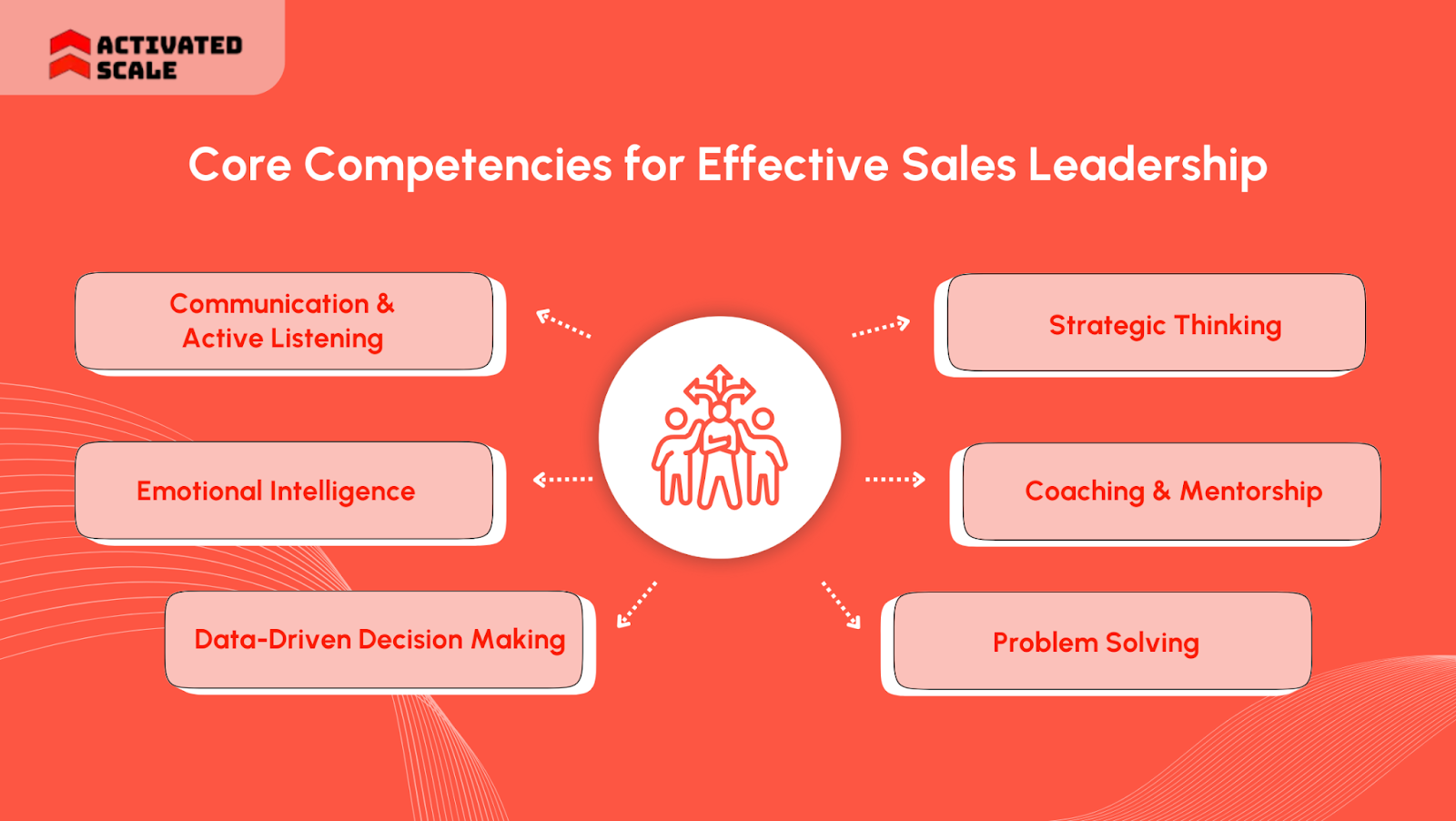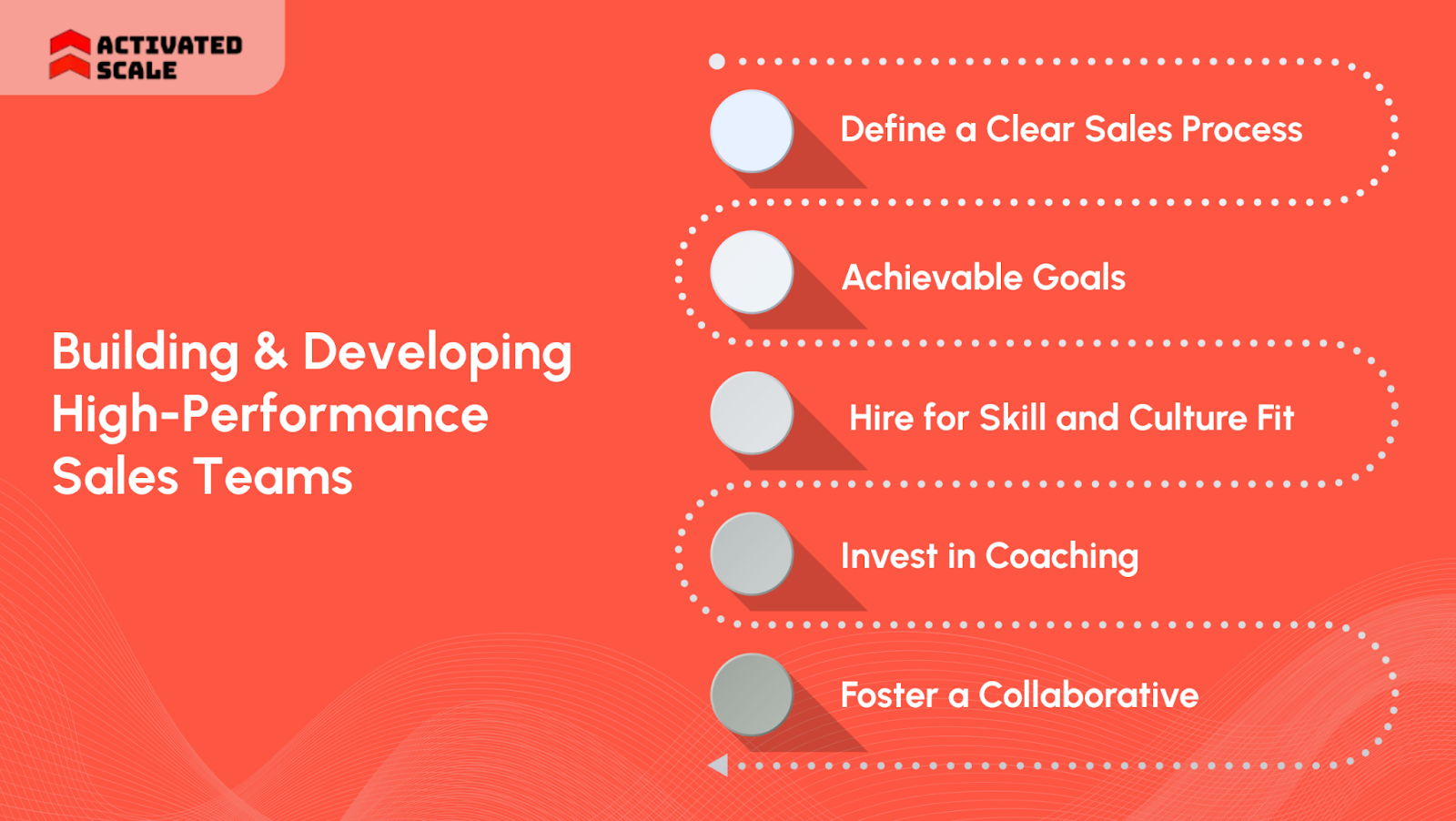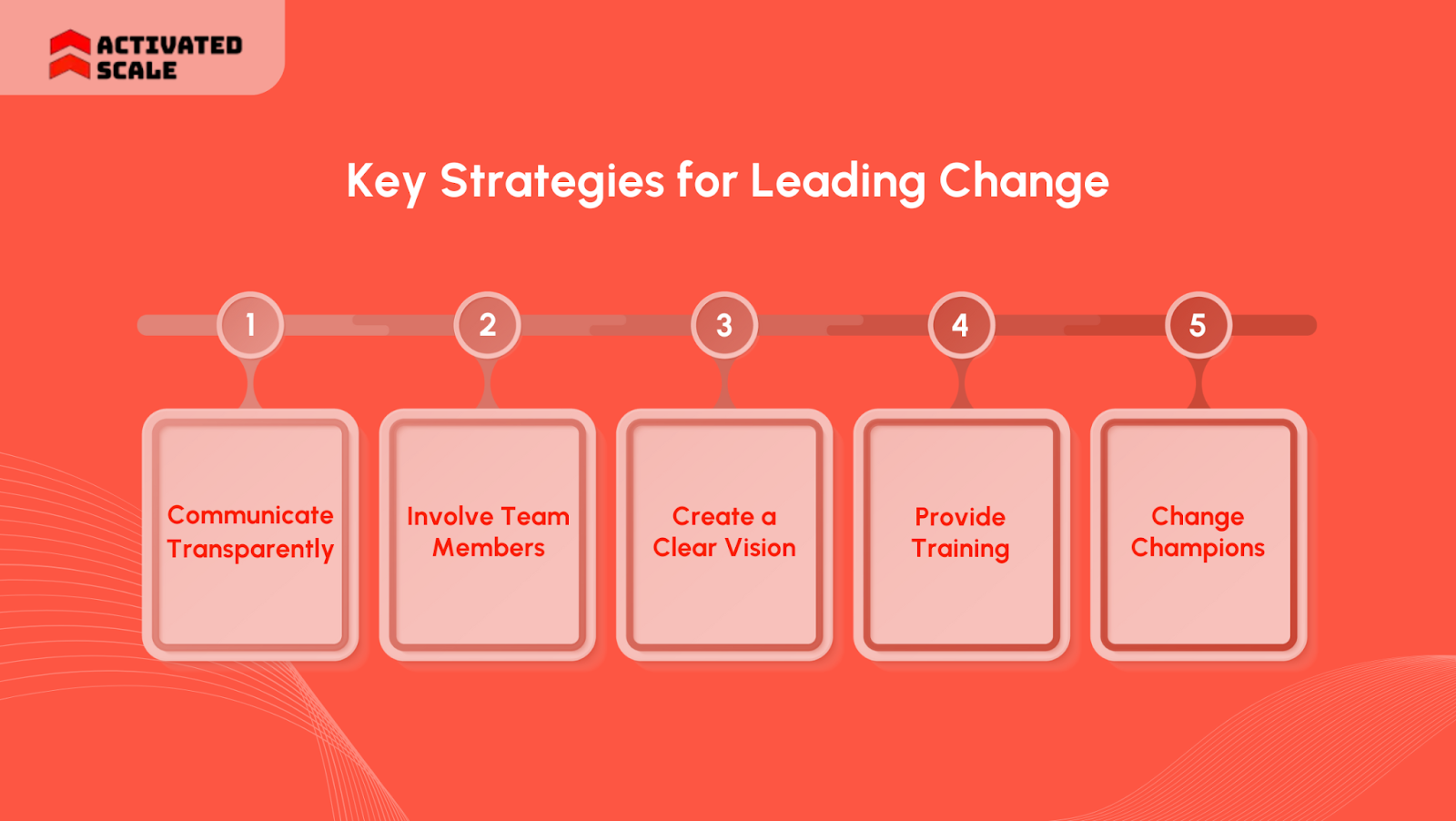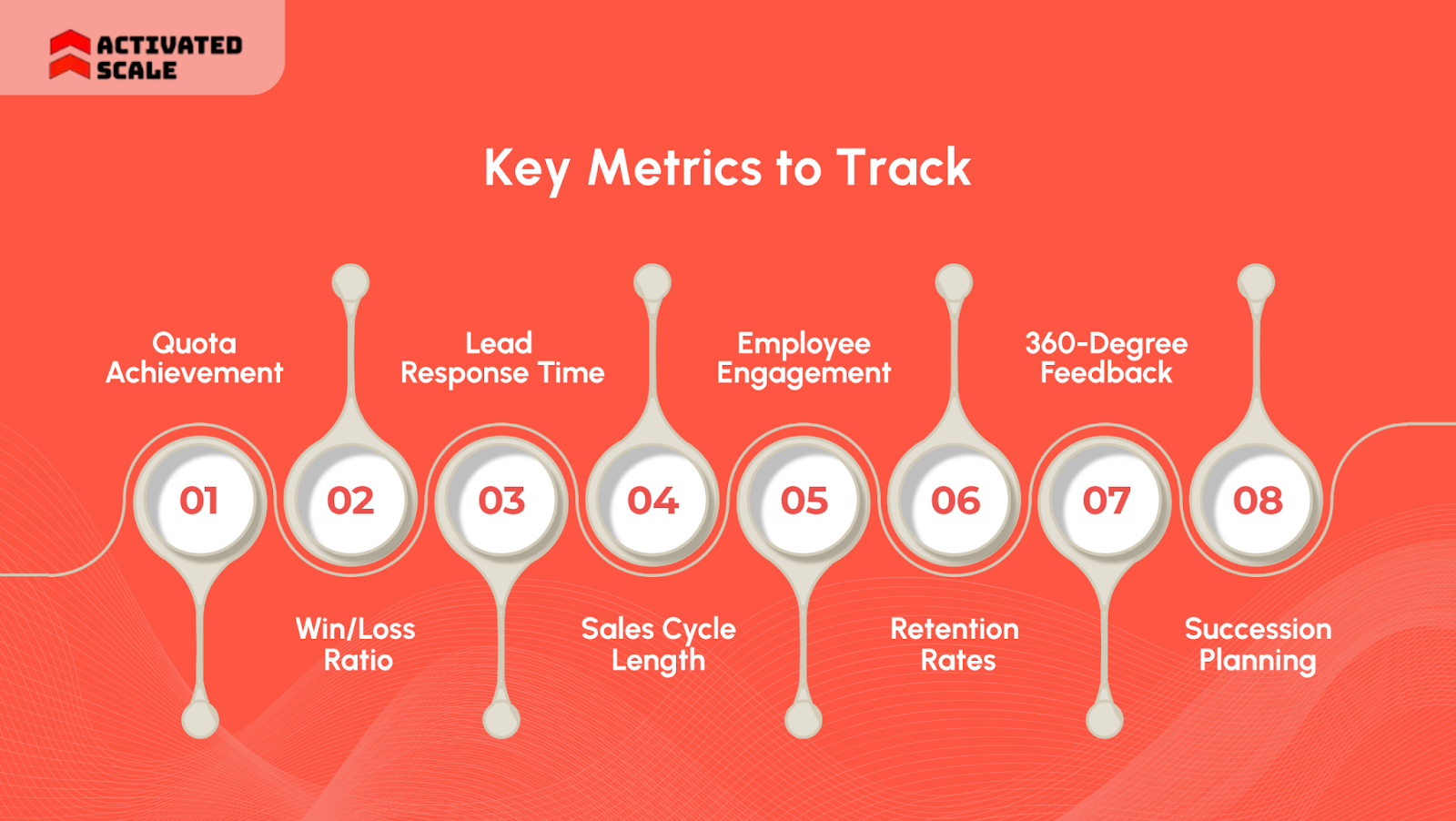Sales leadership today is more complex and critical than ever before. In 2025, successful sales leaders must navigate rapidly evolving markets, leverage data-driven insights, and inspire teams across remote and hybrid environments.
Gone are the days of simply managing pipelines; modern leaders craft strategic visions, foster resilient cultures, and empower their teams to exceed ambitious revenue goals.
This article explores proven strategies, essential skills, and best practices that today’s sales leaders need to lead high-performing, agile teams that thrive in a competitive landscape.
Key Takeaways
- Strong Leadership Philosophy: Lead with intent, fostering adaptability and setting a clear vision.
- Transparent Communication: Align teams with expectations and create space for honest conversations.
- Coaching and Development: Embed continuous learning and personalized support into daily sales activities.
- Leading by Example: Stay actively engaged with your team and key deals to model success.
- Empowering and Accountability: Set ambitious yet achievable goals and create a culture of ownership.
- High-Performing Team Building: Hire for potential, invest in development, and address underperformance proactively.
Understanding Modern Sales Leadership
Sales leadership today goes far beyond managing quotas or pipelines. The role demands a strategic mindset that combines sales expertise with strong leadership qualities.
Modern sales leaders are visionaries who inspire their teams, drive long-term growth, and cultivate a culture of accountability and continuous learning.
Sales Leadership vs. Sales Management: Knowing the Difference
While sales managers tend to focus on day-to-day execution and operational tasks such as pipeline management and forecasting, sales leaders look at the bigger picture.
They set ambitious sales strategies aligned with the company vision, anticipate market shifts, and drive innovation.
Leaders rally their teams around common goals, motivating them to exceed expectations in a dynamic environment.
Core Responsibilities of Sales Leaders
Effective sales leaders are responsible for:
- Developing and executing sales strategies that align with business goals.
- Coaching and mentoring teams to improve skills and performance.
- Building a positive, winning sales culture that retains top talent.
- Ensuring consistent achievement of sales targets through data-driven decision-making.
- Recruiting and nurturing future leaders within the team.
Essential Attributes of Modern Sales Leaders
Today’s sales leaders blend empathy with decisiveness. They understand individual team members' strengths and challenges and adapt their leadership style accordingly. Communication, adaptability, and leading by example are pivotal.
Leaders must communicate clearly, foster open dialogue, and create environments where salespeople feel valued and empowered.
If you’re looking to build a high-impact sales leadership team that scales smoothly, Activated Scale enables flexible hiring of fractional sales executives and leaders, tailoring talent acquisition to your startup’s immediate needs.
Also Read: How to Hire Effective Sales Leaders for Startups
Core Competencies for Effective Sales Leadership

Successful sales leaders possess a unique blend of skills and attributes that enable them to inspire teams, drive results, and adapt to changing market conditions. Mastering these core competencies is crucial for leading high-performing sales organizations in 2025.
1. Communication and Active Listening
Clear communication is fundamental. Sales leaders must articulate goals, expectations, and strategies transparently to align their teams.
Equally important is active listening—understanding team members' challenges and customers' needs helps leaders provide targeted support and build trust.
2. Emotional Intelligence and Empathy
Modern sales leadership requires emotional intelligence: the ability to recognize, understand, and manage one's own emotions and those of others.
Empathy promotes strong relationships within teams, fosters collaboration, and enhances motivation, ultimately improving sales outcomes.
3. Data-Driven Decision Making
Top sales leaders rely on data analytics to guide strategy. They monitor key performance indicators (KPIs), analyze market trends, and use predictive insights to optimize sales processes. Making informed decisions reduces risks and identifies new growth opportunities.
4. Strategic Thinking and Adaptability
Effective leaders anticipate industry shifts and adjust strategies proactively. They align sales efforts with larger business goals and foster a culture that embraces change and innovation. Adaptability ensures teams remain resilient amid uncertainty.
5. Coaching and Mentorship
Nurturing talent through coaching is a hallmark of great sales leadership. Leaders provide ongoing feedback, skill development, and career growth opportunities.
Personalized coaching increases reps’ confidence, accelerates ramp time, and boosts overall team performance.
6. Problem Solving and Conflict Resolution
Sales leaders must swiftly address obstacles, whether internal team conflicts or external market challenges. Strong problem-solving skills allow leaders to act decisively, maintain focus, and keep teams motivated during tough periods.
Also Read: Essential Sales Manager Leadership Skills for Success
Leadership Styles and When to Apply Them

Recognizing the appropriate leadership style for different sales scenarios is key to maximizing team performance.
Successful sales leaders adapt their approach dynamically to meet team needs and align with organizational goals, ensuring agility in a fast-changing market.
1. Transformational Leadership: Inspiring Innovation and Growth
- Encourages creativity and challenges the status quo
- Sets high expectations while fostering a supportive environment
- Ideal for startups and high-growth companies focused on cultural transformation.
2. Democratic Leadership: Collaboration for Collective Success
- Involves team in decision-making and values diverse input
- Promotes ownership, engagement, and motivation
- Works well with experienced, mature sales teams
- Requires balancing inclusion with timely decisions.
3. Coaching Leadership: Developing Individual Potential
- Focuses on mentorship, continuous feedback, and skill development
- Tailors support to individual strengths and weaknesses
- Builds a culture of learning and accelerates new hire ramp-up.
4. Autocratic Leadership: Quick Decisions in High-Pressure Situations
- Makes unilateral decisions with clear directives
- Effective in crisis or fast-paced sales environments
- Risks demotivating the team due to limited input.
5. Laissez-Faire Leadership: Empowering Independence
- Provides autonomy, allowing teams to self-manage
- Best for highly skilled and self-motivated reps
- Requires strong accountability and organization.
To remain agile and effective, activate your sales leadership with Activated Scale’s fractional leadership services—offering flexible access to seasoned executives ready to tailor their style to your company’s unique growth phase.
Also Read: Why Startups Need Outsourced Sales Leadership
Building and Developing High-Performance Sales Teams

Building a sales team that consistently exceeds targets requires strategic focus on recruitment, training, and culture.
Sales leaders must intentionally design processes and environments that motivate reps and foster growth.
1. Define a Clear Sales Process
A well-defined sales process ensures consistency and efficiency. It serves as a roadmap guiding reps from prospecting to closing.
- Standardize each stage with clear entry/exit criteria
- Set measurable milestones and KPIs at every step
- Use the process to align team efforts and improve forecasting.
2. Set Specific and Achievable Goals
Goal-setting directs focus and drives motivation. Goals should be challenging but attainable.
- Link goals to revenue, conversion rates, and customer retention
- Review results regularly and adjust plans as needed
- Celebrate milestones to boost morale and reinforce behavior.
3. Hire for Skill and Culture Fit
Recruitment impacts team performance significantly. Prioritize candidates who are motivated, communicate well, solve problems, and align with company values.
- Build diverse teams with complementary strengths
- Implement structured interviews and assessments
- Focus on both current skills and growth potential.
4. Invest in Coaching and Development
Continuous skill development accelerates ramp time and productivity.
- Use role-playing and real-world scenario training
- Provide personalized coaching based on individual needs
- Encourage knowledge sharing and peer learning.
5. Foster a Collaborative and Accountable Culture
Strong teams thrive on trust, open communication, and shared accountability.
- Hold regular team meetings and feedback sessions
- Recognize successes publicly
- Address performance issues quickly and constructively.
Also Read: Effective Sales Team Building Strategies and Activities
Advanced Coaching Frameworks and Methodologies for Sales Leadership
Effective sales coaching is vital for developing talent and improving team performance. Modern sales leaders use structured coaching frameworks that provide clarity, consistency, and measurable progress in skill development.
Strong coaching creates high-performing sales teams by addressing individual skill gaps through personalized guidance.
Coaching frameworks ensure systematic support, enabling reps to build confidence and accelerate ramp time.
The GROW Model: Goal-Oriented Coaching
The GROW framework helps coaches and reps define:
- Goal: The desired outcome or objective
- Reality: Current situation and challenges
- Options: Strategies and choices available
- Will: Commitment to specific actions.
This model fosters clarity and empowers reps to take ownership of their development path.
OSKAR Model: Solution-Focused Coaching
The OSKAR model emphasizes action and problem-solving in five stages:
- Outcome: Define the coaching session’s goal
- Scaling: Measure current performance level
- Know-How: Identify skills and knowledge needed
- Affirm & Action: Reinforce positive behavior and plan next steps
- Review: Reflect on progress and adjust as necessary.
OSKAR encourages continuous improvement and resilience.
SPRINT Coaching Cycle: Continuous Progress
SPRINT coaching involves short, focused cycles of coaching with three phases:
- Prepare: Identify objectives and topics before sessions
- Engage: Conduct a session with active dialogue and feedback
- Advance: Follow up with tasks and monitor progress.
Frequent, iterative coaching keeps momentum and adaptation constant.
Best Practices for Implementing Coaching Frameworks
- Set clear expectations and align coaching goals with business objectives
- Use data and performance analytics to inform coaching conversations
- Encourage open communication and create safe spaces for honest feedback
- Mix one-on-one and group coaching to leverage peer learning
- Schedule regular sessions to maintain consistency and build trust.
Also Read: Sales Leader: Definition, Skills, Responsibilities and Steps to Become One
Creating a Winning Sales Culture
A strong sales culture shapes how sales teams collaborate, communicate, and perform. It is the collective set of values, behaviors, and habits that drives engagement, accountability, and ultimately, sales success.
What is Sales Culture?
Sales culture refers to the shared attitudes, values, and habits within a sales organization. It encompasses how salespeople approach their work, interact with customers and each other, and contribute to the company’s goals. A positive sales culture fosters motivation, trust, and continuous improvement.
Key Components of a Successful Sales Culture
- Strong Leadership: Effective leaders shape culture by setting clear expectations, protecting their teams, and modeling desired behaviors.
- Shared Vision: A unifying purpose aligns the team towards common goals, creating meaning beyond daily tasks.
- Open Communication: Transparency encourages honest feedback, knowledge sharing, and quicker problem-solving.
- Accountability: Clear standards and consistent follow-up hold team members responsible, promoting high performance.
- Recognition and Motivation: Celebrating achievements, big and small, keeps morale high and drives sustained effort.
- Collaboration: A team-oriented environment fosters support, learning, and shared success.
- Continuous Development: Opportunities for coaching, training, and professional growth keep skills sharp and engagement strong.
Why is Sales Culture Critical?
Strong sales cultures deliver measurable business outcomes, including higher productivity, better retention, and increased revenue. They create environments where reps want to stay, grow, and contribute their best work consistently.
Also Read: Integrate Fractional Sales Leaders for Team Growth
Flexible Leadership Models for Growing Organizations
Growing organizations face frequent change and uncertainty. Flexible leadership models enable leaders to adapt their styles to dynamic team needs, business goals, and external market shifts, supporting sustainable growth and responsiveness.
Key Flexible Leadership Approaches

- Situational Leadership: Leaders adjust their approach based on team maturity, task complexity, and urgency. This fluidity helps balance guidance and autonomy tailored to each scenario.
- Transformational and Transactional: Transformational leadership inspires and motivates through vision and innovation; transactional focuses on structure, rewards, and compliance. Flexible leaders blend these to suit strategic needs.
- Democratic Leadership: Involving team members in decisions encourages ownership and diverse perspectives but requires timely judgment calls to maintain momentum.
- Servant Leadership: Prioritizing team members’ growth and well-being builds trust and engagement, key to long-term retention and performance.
Also Read: Fractional Sales Teams for Unlocking Growth
Cultivating Flexible Leadership Skills
- Practice emotional intelligence and cultural awareness to read team signals effectively.
- Seek continuous feedback and reflect on leadership impact
- Partner with mentors experienced in diverse leadership styles
- Embrace experimentation and adapt based on results
- Maintain clear communication and consistent core values amidst changes.
Benefits for Growing Organizations
Flexible leadership cultivates agile, innovative teams capable of navigating complexity. It enhances employee engagement, accelerates problem-solving, and aligns leadership actions with evolving company goals.
Activated Scale offers fractional sales leadership that brings adaptable, experienced executives ready to scale startups flexibly and cost-effectively while meeting the unique challenges of each growth phase.
Also Read: Fractional Sales Leadership for Scaling Success
Performance Management and Accountability Systems
Without structured systems, sales efforts can become misaligned, and underperformance may go unaddressed.
Strong performance management processes provide visibility into individual and team progress, helping leaders make timely decisions to support or course-correct.
1. Setting SMART Goals and KPIs
- Specific: Clear and focused objectives
- Measurable: Quantifiable indicators to track progress
- Achievable: Realistic targets that challenge but motivate
- Relevant: Aligned with broader business goals
- Time-bound: Defined deadlines for accountability.
Aligning sales goals with SMART criteria ensures clarity and direction for sales teams.
2. Regular Performance Reviews and Feedback Loops
- Schedule consistent one-on-one and team check-ins
- Use data-driven insights to highlight successes and opportunities
- Foster open, constructive communication focused on growth
- Encourage self-assessment and peer feedback to promote engagement.
3. Addressing Underperformance Effectively
- Identify root causes using data and direct conversations
- Develop tailored improvement plans with clear expectations
- Provide coaching and resources to support skill-building
- Establish consequences aligned with company policies if progress stalls.
4. Celebrating Success and Reinforcing Positive Behaviors
- Publicly acknowledge achievements to boost morale
- Use incentives tied to desired outcomes to motivate teams
- Share success stories that exemplify organizational values.
Also Read: Cutting-Edge Sales Performance Metrics to Boost Efficiency
Leading Through Change and Uncertainty
Change often triggers resistance due to natural human tendencies favoring stability. Sales leaders must recognize and address this resistance empathetically to ensure smooth transitions.
Understanding the neuroscience of change helps leaders foster psychological safety and reduce anxiety.
Key Strategies for Leading Change

- Communicate Transparently and Frequently: Share the reasons behind changes, anticipated impacts, and expected benefits. Open communication builds trust and reduces uncertainty.
- Involve Team Members: Engage salespeople by soliciting their input and addressing concerns. Involving the team fosters ownership and eases adoption.
- Create a Clear Vision: Present a compelling future state to motivate and align the team towards common goals.
- Provide Training and Support: Equip teams with the necessary skills and resources to navigate new tools, processes, or market conditions effectively.
- Identify Change Champions: Leverage influential team members to model behaviors and encourage peers to embrace change.
Managing Resistance and Measuring Success
- Anticipate concerns and address them proactively through coaching and feedback.
- Monitor adoption rates and performance metrics to assess change effectiveness.
- Celebrate early successes linked to change initiatives to reinforce positive momentum.
Building Team Resilience
Developing a culture of continuous learning and agility prepares sales teams to adapt quickly to future disruptions.
Leaders should encourage experimentation, learning from failures, and maintaining focus on long-term objectives.
Also Read: High-Performing Sales Activities Examples and Guide
Measuring and Optimizing Sales Leadership Effectiveness
Measuring leadership effectiveness helps identify strengths and areas for improvement, ensuring leadership activities align with business goals.
It enables data-driven decisions to enhance coaching, motivation, and strategy adaptation.
Key Metrics to Track

- Quota Achievement Rate: Percentage of sales reps meeting or exceeding their sales targets, indicating the leader’s ability to drive team success.
- Win/Loss Ratio: Proportion of closed deals won versus lost, reflecting the effectiveness of sales strategies and leadership coaching.
- Lead Response Time: The Speed at which sales reps engage new leads, critical for capturing opportunities early and improving conversion rates.
- Sales Cycle Length: Average time to close a deal; shorter cycles generally suggest efficient sales leadership and processes.
- Employee Engagement Scores: Measures morale and commitment levels, as engaged teams often perform better and stay longer.
- Retention Rates: High retention indicates a healthy sales culture fostered by strong leadership.
- Leadership 360-Degree Feedback: Collects input from peers, direct reports, and managers to provide a comprehensive view of leadership performance.
- Succession Planning Success: Tracks the development and promotion of internal talent to maintain leadership continuity.
Also Read: Essential Sales Development KPIs for Maximizing Team Success
Continuous Improvement Practices
- Regularly review performance data and adjust leadership development plans accordingly.
- Solicit ongoing feedback from sales teams to identify pain points and opportunities.
- Align leadership goals with evolving business strategies for sustained growth.
- Invest in learning and development to enhance leadership skills and stay current with trends.
Conclusion
Effective sales leadership is not about issuing orders or merely overseeing pipelines; it requires a multifaceted and deliberate approach.
Successful sales leaders cultivate a strong leadership mindset that embraces adaptability, clear communication, and a vision that inspires their teams to excel.
Sales leadership is an ever-evolving discipline. To remain effective, leaders must commit to continuous learning, refine their skills, and respond proactively to new challenges.
How Activated Scale Supports Your Sales Leadership Needs
- Connects startups with vetted, experienced fractional sales leaders tailored to the growth stage and budget.
- Enables flexible engagements: part-time, fractional, or contract-to-hire sales leadership.
- Accelerates sales team development with expert coaching, process optimization, and go-to-market strategies.
- Provides cost-effective access to senior sales executives without the overhead of full-time hires.
- Offers risk-free matching guaranteed by a thorough vetting and rematch policy.
Activate your sales leadership potential today with Activated Scale’s fractional sales leadership solutions, accelerate growth, reduce risk, and build scalable sales teams efficiently.
FAQs
1. What are the key skills every sales leader should have?
Essential skills include emotional intelligence, effective communication, data-driven decision-making, coaching ability, and adaptability.
2. How does sales leadership differ from sales management?
Sales leaders focus on vision, strategy, team motivation, and culture, while sales managers typically handle day-to-day operations and execution.
3. Why is coaching important in sales leadership?
Coaching accelerates skill development, boosts morale, and aligns individual performance with company goals.
4. What leadership styles work best in sales?
Transformational, coaching, and situational leadership styles are often most effective for dynamic sales environments.
5. How can sales leaders build a positive sales culture?
By fostering transparency, recognizing achievements, encouraging collaboration, and aligning culture with business objectives.
6. What role does technology play in modern sales leadership?
Technology provides data insights, automates tasks, enhances communication, and supports remote and hybrid teams.
7. How do sales leaders handle change and uncertainty?
Through transparent communication, team involvement, clear vision, training, and by building resilience.
8. How can sales leadership performance be measured?
Using metrics like quota attainment, win rates, employee engagement, and 360-degree feedback.
The Ultimate Guide to Hiring a Salesperson!
Get the step-by-step guide to hiring, onboarding, and ensuring success!
_edi.png)




